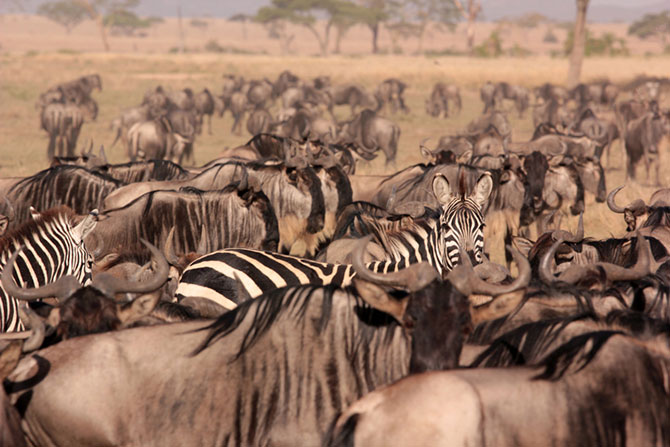The Great Migration takes place twice a year when tens or hundreds of thousands of wildebeests (bearded gnus) and zebras travel from the Masai Mara in Kenya to the Tanzanian Serengeti and then back. They follow the rains and concomitant forage in this vast, contiguous savanna home to a major segment of African wildlife. Wildebeests are strange, ungainly animals that look as if they had been assembled from leftover parts of several other animals. Not much smarter than they look, they comprise the bulk of the Great Migration, while the elegant accompanying zebras provide the brains of the movement. It is the zebras that provide direction and keep a sharp lookout for predators along the way. As we drove westward into the Serengeti on the bumpy dirt road to our safari lodge, we were halted for at least half an hour as a small contingent of the great hoard crossed our track on their journey south. Later, we watched three lionesses stalking a small herd and saw firsthand how the vigilance of the zebras precluded a successful kill.
The Great Migration is best experienced from the air, so we signed on for a hot air balloon ride. Arising at 4:30 a.m., we drove to the launch site and found our balloon with pigeonhole basket lying on its side. We inserted ourselves, the propane was fired up, and the balloon began to fill and rise, pulling the basket upright before we floated off shortly after dawn. When we reached altitude, we were amazed to see that the river of migrating animals reached from horizon to horizon, appearing like a stream of ants. Only from the air could you fully grasp the magnitude of this movement. I began talking to our pilot and casually mentioned that my only other balloon ride had been over the Napa Valley vineyards. His response: “That’s where I learned to fly.” He had come to Africa on safari, fallen in love with the land, and started his own balloon company. What a small world it can be!
After a spectacular flight viewing the endless flow of migrating animals, it was landing time. The pilot explained that the tricky part was avoiding the acacia trees dotting the savanna, as they have sharp, three-inch thorns that could easily shred our balloon, cause a crash, and cost him a major sum of money. With a bit of fast maneuvering by the pilot, we avoided all the thorn trees; the basket dragged the ground and then came to rest on its side. We crawled out of our pigeonholes and were greeted by guides with vehicles, who quickly whisked us to a long table complete with silver, china, and champagne set up in the middle of nowhere. A turbaned, elegantly dressed attendant offered us wash water in a silver bowl and a clean towel, after which we sat down to a sumptuous breakfast. Only in Africa would you find this perfect end to an amazing adventure.




